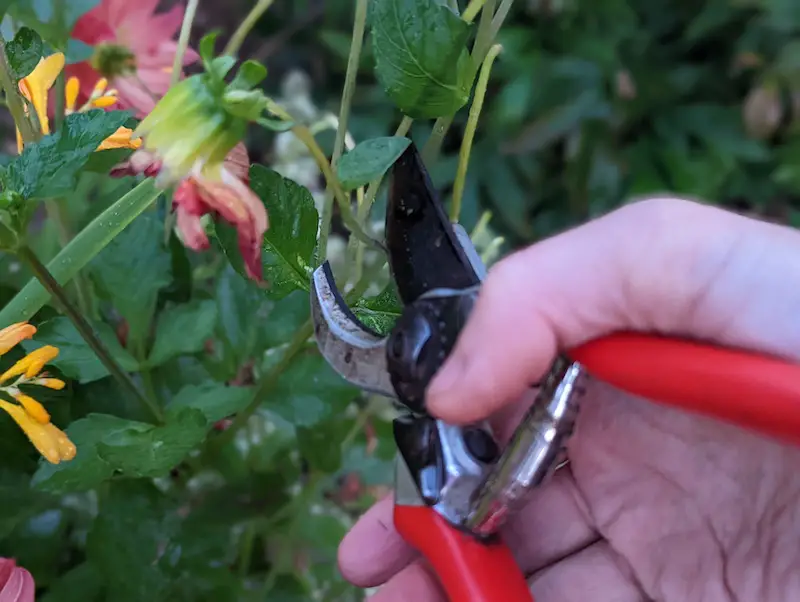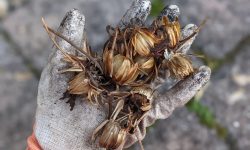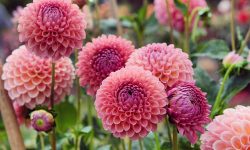Dahlias are among the most captivating flowers you can grow, known for their brilliant colors and endless shapes. They fill gardens with life from midsummer until frost, creating waves of beauty that seem almost effortless. But behind every perfect bloom is careful pruning — the key to stronger plants, larger flowers, and longer blooming seasons. Pruning dahlias is not about cutting randomly; it’s about understanding how the plant grows and how to guide it to perform its best. When done correctly, pruning turns an ordinary dahlia into a masterpiece of color and structure.
Many gardeners underestimate the power of proper pruning, yet it’s one of the most effective ways to keep dahlias blooming continuously. Pruning shapes the plant, controls height, and stimulates new growth, leading to more flower buds. It also improves airflow and reduces the risk of disease, keeping the plant vigorous throughout the season. Whether you grow dahlias in containers or garden beds, learning how to prune them the right way ensures a constant flow of healthy, radiant blooms that transform your space into a living display of color.
Understanding Why Pruning Dahlias Matters

Pruning dahlias is one of the most important steps for achieving consistent, long-lasting blooms. Without it, plants tend to grow tall, spindly, and unbalanced, focusing their energy on leaves instead of flowers. Pruning directs the plant’s energy toward developing stronger stems and more buds, resulting in a compact, bushy form covered in vibrant blooms. It also helps manage the plant’s overall shape, preventing it from collapsing under its own weight as the flowers grow larger and heavier. When you prune at the right time and in the right way, you’re essentially training your dahlias to produce continuous flowers throughout the season.
Beyond aesthetics, pruning plays a vital role in the plant’s health. Dense, untrimmed foliage often blocks sunlight and traps moisture, creating a perfect environment for fungal diseases like powdery mildew and botrytis. By thinning out stems and leaves, you allow better air circulation, which keeps the plant dry and healthy. This simple practice reduces the need for chemical treatments and extends the life of your dahlias naturally. Proper pruning also prevents overcrowding, allowing nutrients to reach every part of the plant efficiently. Healthy stems and roots mean stronger growth and bigger, more colorful blooms over time.
Another benefit of pruning is control. Dahlias can grow rapidly, especially in warm, fertile conditions, and can easily become unruly. Regular trimming helps maintain a balanced structure that’s easier to manage, especially for taller varieties prone to bending. It also encourages the formation of multiple side shoots, each capable of producing its own flowers. This process results in a longer bloom period, as new buds continue to develop while older ones fade. In essence, pruning transforms your dahlias from single-bloom wonders into season-long performers that fill your garden or home with constant beauty.
When to Start Pruning Dahlias
The timing of your first pruning has a major impact on how healthy and productive your dahlias will be. Pruning too soon can stunt young growth, while waiting too long allows the plant to grow tall and weak. The ideal moment to start is when your dahlias reach six to eight inches in height. At this stage, the stems are sturdy enough to handle trimming, and the plant has developed several sets of leaves. Removing the growing tip at this time encourages the plant to branch out instead of growing straight upward. Each new branch that forms will later carry buds, resulting in fuller, more abundant blooms throughout the season.
For most gardeners, this first pruning happens in late spring or early summer, depending on your climate. Dahlias need warm soil and consistent sunlight to recover quickly after trimming. Use your thumb and forefinger or clean garden shears to remove the top inch of the main stem, making the cut just above a healthy set of leaves. This process, often called “pinching,” signals the plant to produce new lateral shoots. Within two to three weeks, you’ll see vigorous branching and denser foliage. The plant becomes stronger, more balanced, and capable of supporting multiple blooms without collapsing under their weight. Early pruning lays the foundation for a season of continuous flowering.
After the initial pruning, maintenance becomes an ongoing process. Every few weeks, inspect your plants and remove any damaged, yellowing, or overcrowded stems. This helps improve airflow and directs nutrients toward active growth. As new shoots emerge, continue to shape the plant by trimming back excess growth that shades other stems. For taller varieties, consider pruning lightly after each flush of flowers to stimulate new buds. Consistent, well-timed pruning not only prolongs blooming but also enhances color vibrancy and flower size. By starting early and maintaining throughout the season, you ensure your dahlias stay healthy, structured, and stunning until the first frost.
Tools and Preparation Before Pruning
Before you begin pruning your dahlias, preparing the right tools and setting up your workspace properly is essential. The quality of your tools affects not only the precision of your cuts but also the overall health of your plants. Sharp, clean tools create smooth cuts that heal quickly, reducing the risk of disease. The most important tools for pruning include a pair of sharp garden shears or pruners, a small pair of scissors for delicate stems, and rubbing alcohol or a disinfectant solution. Always sanitize your tools before and after each pruning session, especially if you’re working with multiple plants. This prevents the spread of fungal spores or bacteria that can easily infect open cuts on your dahlias.
It’s also important to consider the time of day and weather conditions before pruning. Early morning or late afternoon is best, as the temperatures are cooler and the sun is less intense. Avoid pruning when the foliage is wet, since moisture increases the risk of disease entering through fresh cuts. Make sure the soil around your dahlias is slightly moist but not soggy; this helps prevent stress to the plant during pruning. Having everything prepared in advance — including gloves, a clean workspace, and a container for trimmings — ensures that your pruning process is efficient and safe.
Another key preparation step is assessing your plants before you make the first cut. Take a few moments to observe the structure of each dahlia, noting which stems are strongest and which are overcrowded or weak. Decide where you’ll make your cuts to maintain a balanced shape. Pruning should enhance the plant’s symmetry, allowing sunlight to reach all leaves evenly. Removing stems that cross or block airflow improves overall plant health and encourages better bud development. Proper preparation and attention to detail before pruning ensure that each cut contributes to stronger, healthier dahlias that produce continuous, spectacular blooms all season long.
Step-by-Step Guide to Pruning Dahlias
Pruning dahlias correctly follows a simple, step-by-step process that builds stronger plants and guarantees continuous flowers. The first step is early pinching, which happens when the plant is about six to eight inches tall. Using your fingers or sterilized scissors, pinch off the top inch of the main stem just above a set of leaves. This small action stimulates new side shoots to grow from the nodes below the cut. Within a couple of weeks, the plant becomes fuller and develops multiple flowering stems instead of one tall stalk. This early shaping is crucial for creating a balanced framework that can support heavy blooms later in the season.
The second step focuses on mid-season pruning, which keeps the plant productive once it starts blooming. During this phase, remove any weak, crowded, or inward-growing stems that block airflow and light. This keeps the plant open and encourages new shoots to develop near the base. After each flush of flowers, cut the spent stems back to a pair of healthy leaves to promote fresh growth. This method, known as selective pruning, ensures that the plant directs its energy toward producing new buds instead of maintaining old growth. Each cut stimulates regrowth, extending the flowering period well into autumn.
Finally, perform maintenance pruning throughout the blooming season to sustain vigor. Regularly check for dead or damaged leaves, removing them to prevent disease buildup. Trim away stems that rub against one another, as friction can create wounds where pathogens enter. For taller varieties, pruning helps balance weight and prevents bending under large blooms. Cutting back excessive top growth also improves stability and air circulation, which are vital for long-term health. By following these steps consistently — early pinching, mid-season trimming, and regular maintenance — your dahlias will stay vibrant, healthy, and full of color from midsummer until frost.
How to Deadhead Dahlias for Continuous Flowers
Deadheading is one of the most effective techniques for keeping dahlias blooming continuously. It involves removing faded or spent flowers to encourage the plant to produce new buds instead of setting seeds. When a dahlia finishes blooming, it naturally begins redirecting energy toward seed development, which slows or stops further flowering. By cutting away the old blooms, you trick the plant into thinking it hasn’t completed its reproductive cycle, prompting it to grow new flowers. This simple yet powerful practice can extend your blooming season by several weeks or even months. The more consistently you deadhead, the more energy your plant will devote to fresh, vibrant blooms.
To deadhead correctly, identify which blooms have finished flowering. A spent dahlia usually looks slightly droopy, and the petals begin to lose their brightness or curl inward. Trace the flower stem back to the first set of healthy leaves or a side shoot and make a clean cut just above it using sterilized pruning shears. This prevents the stem from drying unevenly and helps the plant heal quickly. Removing flowers early in their decline prevents seed formation and stimulates faster bud production. In most cases, you’ll see new growth emerging within days, keeping your plant lush and productive.
For gardeners with large dahlia collections, deadheading also helps maintain a tidy, well-kept appearance. Faded blooms can make the plant look tired, while regular trimming keeps it looking fresh and full. Performing this task every few days during peak bloom season ensures that no wilted flowers drain energy from the plant. Indoors, potted dahlias benefit just as much from deadheading — it encourages compact, controlled growth and prevents legginess. This consistent routine not only maximizes the number of blooms but also enhances their color intensity and lifespan. With proper deadheading, your dahlias will reward you with an endless display of healthy, radiant flowers.
Pruning Different Types of Dahlias
Decorative Dahlias
Decorative dahlias are among the most popular varieties, prized for their large, layered blooms and bold colors. Because these flowers are heavy, pruning plays a key role in supporting their structure and ensuring long-lasting performance. Begin pruning decorative dahlias early by pinching the central stem once the plant reaches six to eight inches in height. This encourages multiple strong branches capable of holding big blooms. As the plant grows, remove weak or inward-facing stems to allow better airflow and light penetration. This reduces the risk of fungal diseases, which can easily affect dense foliage. Regular deadheading after each bloom cycle ensures continuous flowering throughout summer.
When decorative dahlias reach full size, pruning becomes even more important to maintain balance. Their large blooms can weigh down stems, especially after rain. Trim away smaller side buds to allow one or two main flowers per stem — this produces larger, showier blossoms. Cutting back old stems after each flush of flowers also stimulates new growth and prevents the plant from becoming top-heavy. With consistent shaping, decorative dahlias develop into strong, symmetrical plants that deliver magnificent blooms until the first frost.
Cactus Dahlias
Cactus dahlias are known for their spiky, star-like petals that give them a dramatic, sculptural appearance. These vigorous growers often reach impressive heights, so pruning is vital to keep them controlled and full of blooms. Begin by pinching the main growing tip when the plant reaches about eight inches tall. This encourages branching and helps create a strong framework for supporting large, spiky flowers later on. Cactus dahlias benefit from thinning the lower stems to improve air circulation, which reduces the risk of mildew or fungal infection in humid weather.
Midseason pruning is particularly effective for cactus dahlias. Once the first blooms fade, cut those stems back to just above a set of healthy leaves. This step encourages new side shoots to grow and bloom, extending the flowering season well into autumn. Because cactus dahlias often produce multiple buds close together, removing a few smaller buds ensures the remaining ones open larger and stronger. Consistent pruning keeps the plant upright and balanced, while regular deadheading prevents wasted energy on seed production. With this care, cactus dahlias deliver a stunning, long-lasting display of bold, spiky blooms that hold their shape even in heat and wind.
Pompon Dahlias
Pompon dahlias are beloved for their perfectly round, globe-shaped flowers that look flawless from every angle. These smaller dahlias tend to grow compactly, but even they benefit from light pruning to encourage dense growth and continuous flowering. Early in the season, pinch the top of the main stem to encourage branching and multiple flowering points. This ensures a more even distribution of blooms and a fuller appearance. Because pompon dahlias are naturally symmetrical, pruning helps maintain shape and keeps the plant from becoming too crowded in the center.
During the blooming season, focus on maintenance pruning rather than aggressive trimming. Remove weak inner shoots or leaves that shade other parts of the plant. Deadhead frequently by cutting spent blooms down to a pair of healthy leaves, stimulating new buds to form quickly. Light pruning every few weeks helps maintain airflow and prevents fungal buildup, especially in humid conditions. Pompon dahlias respond quickly to care, producing hundreds of petite, perfectly formed blooms that remain fresh and bright from midsummer through fall. Their tidy, balanced form makes them ideal for garden borders, containers, and cut-flower arrangements that stay beautiful for days.
Dinner-Plate Dahlias
Dinner-plate dahlias are the giants of the dahlia world, with blooms so large they can measure ten inches or more across. Because of their impressive size, pruning is essential to prevent the plant from becoming top-heavy or breaking under its own weight. Begin early by pinching the central stem when the plant is about eight inches tall. This step creates strong, branching growth that can support enormous flowers. As the plant matures, remove weak stems and interior shoots that crowd the center, ensuring plenty of airflow and light exposure. This encourages strong, disease-free growth and vibrant, full-sized blooms.
As flowering begins, focus on selective disbudding to enhance bloom quality. Remove smaller side buds near the main flower bud to direct the plant’s energy into producing one large, flawless bloom per stem. After flowers fade, cut the stem back to a pair of healthy leaves to promote new growth and the next wave of blooms. Regular pruning also reduces strain on the plant and helps maintain upright stems, especially when paired with staking. With consistent trimming and care, dinner-plate dahlias produce spectacular, oversized flowers that remain sturdy and brilliant from midseason until the first frost.
Common Mistakes to Avoid When Pruning Dahlias
Pruning Too Early or Too Late
Timing is everything when pruning dahlias, and one of the most common mistakes gardeners make is cutting too early or too late. Pruning too early, before the plant reaches six inches tall, can damage young growth and stunt development. Early cuts remove the plant’s main energy source, preventing it from forming a strong base. On the other hand, pruning too late allows dahlias to become tall and leggy, making it difficult to shape the plant properly. Late pruning also shocks mature plants, which may slow down blooming or cause stress-related dieback.
The key is to start pruning when stems are sturdy but still flexible — usually at the six to eight-inch stage. This allows for balanced shaping without harming early growth. After the first pruning, continue light trimming every few weeks instead of performing one heavy cut later in the season. Consistent timing keeps dahlias compact, strong, and capable of producing more flowers. By pruning at the right moment, you ensure steady growth, faster recovery, and a longer, healthier blooming season.
Over-Pruning and Excessive Cutting
While pruning encourages more blooms, cutting too much can have the opposite effect. Some gardeners mistakenly remove too many stems or leaves, leaving the plant with limited energy reserves. Each leaf plays a role in photosynthesis, which powers flower production. When too many are removed, dahlias struggle to produce buds and may even stop blooming temporarily. Over-pruning also exposes the plant to sunburn or dehydration, especially during hot weather. The goal of pruning is balance — removing just enough growth to promote airflow and shape without depleting the plant’s resources.
To avoid over-pruning, focus on selective cuts that target weak, crossing, or damaged stems rather than removing large portions of foliage at once. Always leave several healthy stems and leaves intact to sustain energy flow. If the plant looks thin or sparse after pruning, you may have gone too far. In that case, let it recover for a few weeks before trimming again. Remember that moderate, consistent pruning is more effective than aggressive cutting. Healthy dahlias need leaves as much as they need flowers — balance ensures both flourish beautifully.
Ignoring Tool Hygiene
Another common mistake is overlooking tool hygiene. Dirty or dull pruning tools can spread disease quickly between plants. Fungal spores, bacteria, and even viral infections can survive on blades and transfer with each cut. Once infected, dahlias may show blackened stems, wilted leaves, or slowed growth, severely affecting blooming. Using unclean tools also causes jagged cuts that heal poorly, leaving openings for pathogens to enter. This small but often-forgotten step can undo all your pruning efforts and reduce the plant’s lifespan.
To prevent contamination, always clean your tools before and after each pruning session. Wipe blades with rubbing alcohol or a disinfectant solution to kill germs. Keep shears sharp for precise, clean cuts that heal quickly. For gardeners pruning multiple dahlias, sanitize tools between each plant to stop potential spread. Maintaining clean tools not only ensures plant health but also improves cutting accuracy, resulting in smoother growth and faster recovery. Pruning hygiene may seem minor, but it’s one of the most powerful ways to keep dahlias disease-free and thriving all season long.
Neglecting Aftercare
Pruning is only half the process — proper aftercare ensures the plant recovers and thrives afterward. A common mistake is failing to water or feed dahlias following pruning. Each cut puts mild stress on the plant, and without proper hydration and nutrients, recovery slows. Some gardeners also prune under harsh sunlight, causing immediate wilting or sunscald on newly exposed stems. Ignoring aftercare can leave dahlias weak, delay blooming, and increase susceptibility to pests or disease.
The best time to prune is early morning or late afternoon when temperatures are mild. After trimming, water the plant deeply to help it recover from the loss of foliage and to stimulate new growth. Applying a light fertilizer high in phosphorus and potassium supports bud formation. Adding mulch around the base helps retain moisture and protect the roots. Regular inspection over the next few days ensures cuts heal properly. With consistent aftercare, dahlias rebound quickly, producing stronger stems and a fresh burst of blooms that last until the season’s end.
Seasonal Pruning Tips for Dahlias
Pruning dahlias changes with the seasons, as each growth phase requires a slightly different approach. Understanding when and how to prune at each stage helps you keep the plants healthy and blooming for months. In spring, focus on shaping and encouraging bushy growth. Once young plants reach about six inches tall, pinch the main growing tip just above a set of leaves. This early pruning step triggers branching and builds a strong framework for summer blooms. If you started dahlias indoors, perform this first pruning before transplanting them outside. Removing weak or thin stems also helps strengthen the plant for the active growing months ahead.
During summer, pruning shifts toward maintenance and flower production. As dahlias enter full bloom, remove any damaged, crossing, or overcrowded stems to allow better airflow and light. This reduces the chance of fungal diseases and helps each flower develop fully. Deadheading becomes essential during this period — cutting away faded blooms encourages the plant to keep producing new buds. After each flush of flowers, lightly trim the stems back to a pair of healthy leaves. This technique keeps dahlias productive and vibrant throughout the hottest months, ensuring that new blooms continuously replace the old.
In autumn, pruning focuses on preparation for dormancy and next year’s growth. As the first frost approaches, stop heavy pruning but continue removing spent flowers and yellowing leaves. Once frost kills the foliage, cut the stems back to about six inches above ground level. This makes it easier to lift and store the tubers for winter. If you live in a mild climate where dahlias can overwinter in the ground, prune lightly to clean up dead growth and apply a thick layer of mulch for protection. Adapting your pruning routine to each season ensures strong, healthy plants that return year after year with even more impressive blooms.
Frequently Asked Questions (FAQ) About Pruning Dahlias
When should I start pruning my dahlias?
Begin pruning when your dahlia plants reach six to eight inches tall. At this stage, the stems are strong enough to handle trimming, and pinching the top growth encourages branching. Early pruning helps create a fuller, stronger plant that produces more blooms later in the season.
How often should I prune dahlias during the season?
Light pruning should be done every few weeks throughout the growing season. Remove weak or overcrowded stems to improve airflow and deadhead spent flowers regularly. This keeps the plant healthy and stimulates continuous blooming until frost.
Can I prune dahlias too much?
Yes. Over-pruning removes too many leaves and stems, which reduces the plant’s ability to produce energy through photosynthesis. This can lead to weak growth and fewer blooms. Always prune selectively, keeping several strong stems and healthy foliage intact for balance.
What tools are best for pruning dahlias?
Use sharp, clean garden shears or pruning scissors for smooth, precise cuts. Disinfect your tools before and after each session with rubbing alcohol or a mild bleach solution to prevent the spread of disease between plants.
Do all dahlia varieties need pruning?
Yes, though the intensity varies. Large varieties like dinner-plate and decorative dahlias require more pruning to manage size and support blooms. Smaller types, such as pompon or dwarf dahlias, need only light pinching and regular deadheading to stay compact and productive.
Conclusion
Pruning dahlias is the key to achieving stronger plants, brighter blooms, and a longer flowering season. Each precise cut guides the plant’s energy toward continuous growth and prevents disease. From early pinching in spring to cleanup in fall, proper pruning keeps dahlias healthy, balanced, and full of color. Whether you grow them in pots or garden beds, consistent care ensures lasting beauty. With just a little attention and timing, your dahlias will reward you with months of vibrant blooms — turning every corner of your garden into a masterpiece of natural elegance.






